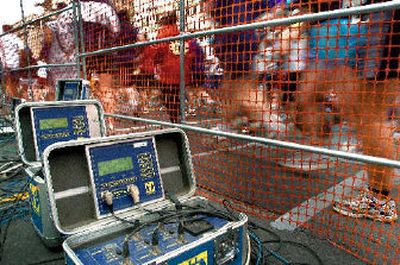A few Bloomin’ hitches

The chip went off without a hitch, although it rubbed some people the wrong way.
That was the feedback Don Kardong, Lilac Bloomsday executive director, received about Sunday’s 30th Bloomsday run. For the first time, racers wore a microchip on their ankles, which kept their time on the 7.46-mile course. The device was held in place by a Velcro ankle bracelet.
“Overall, it was definitely well-received,” Kardong said Monday afternoon.
He said the one complaint he heard was that the bracelet rubbed or cut some ankles. Bloomsday officials, who had been playing out possible ankle-chip scenarios for months, never took that possibility into consideration.
“I don’t know why they had a different experience than I did. It seemed to work the way it was supposed to work,” Kardong said.
Rand Palmer, Bloomsday’s chief volunteer, said when he was observing racers at the seven-mile mark, he saw some sockless runners who were fine.
“But I also saw bloody spots on some people where (the attachment) was rubbing,” he added.
Of the 40,163 people who finished the race, 173 were disqualified, according to figures Monday. None of the disqualified racers had started in the wrong group, although it had been announced that people who did so would be disqualified.
Because this was the first year of the new system, Bloomsday officials were lenient, although they likely will enforce the disqualification rule in the future.
Kardong, who founded Bloomsday in 1977, said the new timing system – where 44,756 registered participants started the race in waves – had a few snags. It’s nothing they can’t tweak next year, Kardong said.
Race officials anticipated the last group of walkers would start at 9:50 a.m., but it turned out to be closer to 10:30. The delay forced them to wait in unseasonably cool 48-degree weather more than 30 minutes longer than they had bargained for.
“We didn’t know how long it was going to take,” Kardong said. “Now we know.”
Race officials don’t foresee moving 45,000 racers through the start any more quickly next year, but people can wait less by arriving later, Kardong said.
The staggered starts, which were done to the tune of 14 different gunshots, did reduce some bottlenecks. However, there were slowdowns after the new finish line on the Monroe Street Bridge.
Kardong said traffic stacked up on the bridge when finishers dropped their chips in the first receptacles, although there were drop-offs all over the bridge.
The T-shirt pickup on Spokane Falls Boulevard also backed up occasionally.
“We can figure out a better way to space that out. We’ll take care of that,” Kardong said of the post-race delays.
When people got to the T-shirt line, some sizes were already gone. Those who want to exchange a shirt for a different size can call the Bloomsday office at (509) 838-1579.
And then there’s the mixed review of the burnt-orange color, or as some racers described it, “pumpkin.”
“We get that every year,” Kardong said about the color choice, “unless it’s some version of blue, but we can’t give them blue every year.”